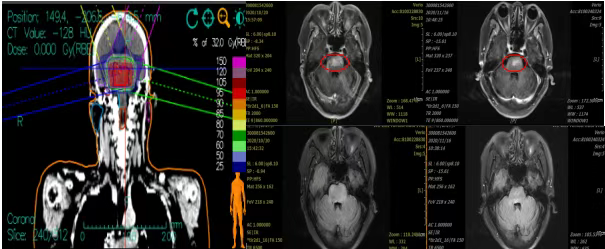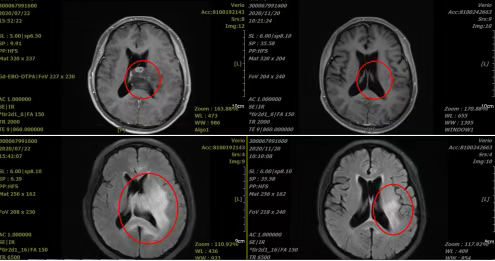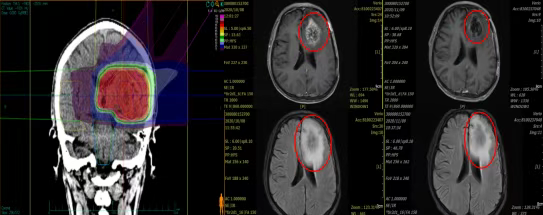Intensity Modulated Carbon-ion Therapy (IMCT) for Central Nervous System Tumors
Intensity Modulated Carbon-ion Therapy (IMCT) for Central Nervous System Tumors
Since our center began operations, we have treated a total of 19 cases of central nervous system tumors, including 8 cases of glioma, 7 cases of brain metastases, and 4 cases of benign brain tumors. The progression-free survival (PFS) rate for all patients was 94.7% (18/19), and the overall survival (OS) rate was 100%. Among these, only one patient who received mixed photon and carbon ion therapy (photon 50Gy/20 fractions + carbon ion 24.3GyE/8 fractions) had suboptimal therapeutic outcomes. The outcomes for the remaining patients treated with carbon ion therapy alone were satisfactory.
It is well known that central nervous system tumors are often located in critical areas, making complete surgical resection difficult and leading to a high risk of recurrence. Conventional photon radiotherapy is often less effective for most central nervous system tumors and can cause significant damage to normal tissues. Carbon ion therapy, with its unique physical and biological advantages, can effectively eradicate tumor cells, achieving excellent local control rates.
The Wuwei Carbon Ion Center has successfully implemented intensity-modulated carbon-ion therapy (IMCT) for central nervous system tumors. By employing fields from different angles, the dose to normal tissues is distributed, meaning the brain tissue along the path of the radiation receives only a very low dose, while a high dose is precisely delivered to the tumor area. This approach not only optimally protects normal tissues and improves patients' quality of life but also allows for a higher radiation dose to the tumor, enhancing local control rates. Below, we share the clinical observation data of some central nervous system tumor patients treated at our center:
Case 1: A 72-year-old female patient presented with complaints of "decreased muscle strength in the right limb, hoarseness, choking when drinking water, and double vision for 5 months." A head MRI indicated a space-occupying lesion in the brainstem, measuring approximately 2.7 * 3.3 cm, suspected to be a glioma. Diagnosis: Brainstem glioma. Carbon ion radiotherapy was initiated on October 26, 2020.

The patient's treatment concluded on November 12, 2020. The patient showed a significant increase in limb muscle strength, and symptoms such as hoarseness, drinking cough, and binocular diplopia were alleviated. A review of the head MRI indicated that the brainstem glioma had decreased in size compared to before treatment, measuring approximately 2.0 * 3.1 cm, with enhanced weakening and no significant edema.
Case 2: The patient, female, 44 years old, sought medical attention due to "right lower limb weakness for over 2 years." A head MR showed diffuse abnormal signals in the bilateral lateral ventricles, corpus callosum, and left thalamus, suggesting glioma (Grade II-III). Diagnosis: Brain glioma. Carbon-ion radiotherapy began on July 28, 2020.

Treatment ended on August 24, 2020. The patient's limb muscle strength significantly increased, and no discomfort occurred during treatment. A review head MRI showed that the glioma in the bilateral lateral ventricles, corpus callosum, and left thalamus had significantly decreased in size compared to before treatment, and edema had reduced
Case 3: The patient, male, 39 years old, sought medical attention due to "more than 1 year after resection of medulloblastoma." Postoperative pathological diagnosis was medulloblastoma, classic type, WHO Grade IV. The patient underwent intensity-modulated radiotherapy after surgery. A review head MRI one year later showed a space-occupying lesion in the left frontal and temporal lobes, with abnormal signals in the left medial frontal and left frontal insula, measuring 5.0 * 3.5 cm, indicating tumor recurrence. Carbon-ion radiotherapy began on October 15, 2020.

Treatment concluded on November 9, 2020. The patient's memory significantly improved, reactions became sharper, headaches completely resolved, and no discomfort occurred during treatment. A review head MRI showed that the space-occupying lesion in the left frontal and temporal lobes and the focus in the left medial frontal and left frontal insula had shrunk compared to before, measuring 4.1 * 2.7 cm, with reduced enhancement and edema.
Intensity Modulated Carbon-ion Therapy (IMCT) for central nervous system tumors is non-invasive, painless, has a short treatment course of 8-16 sessions, offers good efficacy, and has minimal side effects. The development of this technology represents another clinical breakthrough for the Wuwei Heavy Ion Center in treating refractory tumors and opens up broader prospects for heavy-ion therapy in central nervous system tumors.
Indications for Heavy-Ion Therapy
Central nervous system tumors: glioma, meningioma, acoustic neuroma, skull base tumor, chordoma.
Head and neck tumors: ocular tumors (retinoblastoma, ocular melanoma), nasopharyngeal cancer, oral cancer, pharyngeal cancer, laryngeal cancer.
Chest and abdominal tumors: lung cancer, breast cancer, esophageal cancer, mediastinal tumor, liver cancer, pancreatic cancer.
Pelvic tumors: prostate cancer, bladder cancer, recurrent rectal cancer, cervical cancer, endometrial cancer, and other unresectable pelvic tumors.
Various bone and soft tissue sarcomas
Consultation and Appointment
Contact Person:
Director Wu +86 13909357563
Dr. Yan +86 13893552066
Telephone: +86 0931-2122056
Lanzhou Heavy Ion Consultation Office
Address: No. 738, Nanchang Road, Chengguan District, Lanzhou City
Preliminary Review: Zhang Lihong
Final Review: Zhang Jie
